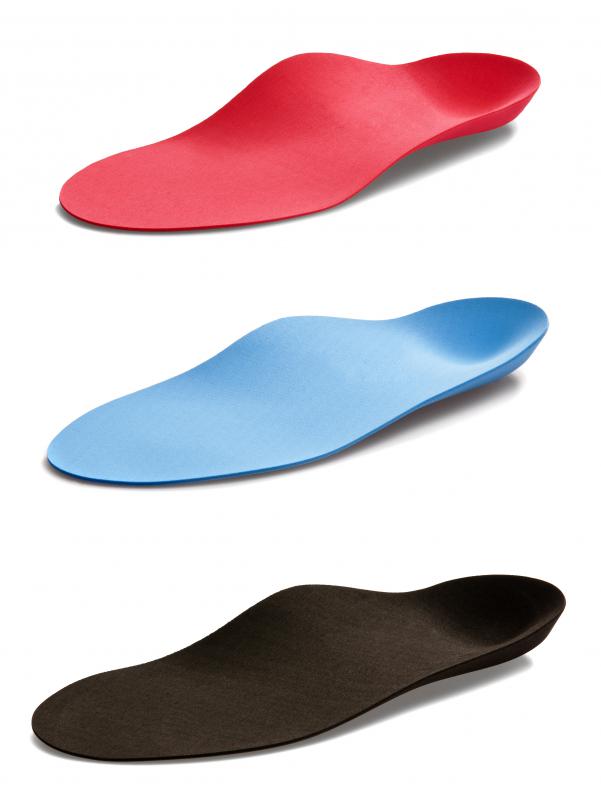At TheHealthBoard, we're committed to delivering accurate, trustworthy information. Our expert-authored content is rigorously fact-checked and sourced from credible authorities. Discover how we uphold the highest standards in providing you with reliable knowledge.
What are Shoe Inserts?
The term “shoe inserts” refers to orthotic devices placed in the sole of the shoe. They are used to treat pain and a variety of other conditions caused by malformed feet, sports injuries, bad shoes, or improperly balanced walking. Shoe inserts are designed to cushion the foot and even out pressure on the walking surface. They can be prescribed by a doctor and custom made, or purchased over-the-counter at pharmacies.
Any chronic foot pain is abnormal, and it can lead to leg, knee, and back problems if left untreated. A podiatrist can assess the patient’s feet and decide if orthotic shoe inserts are appropriate. Symptoms a doctor might investigate include bunions, flat feet, chronic heel or shin pain, and frequently sprained ankles. The doctor should look at the patient’s gait to see if the toes are pointed too far in or out, and he might even check the insides of the patient’s shoes to see if poorly balanced foot movement is indicated by uneven wear in the shoe.

Shoe inserts may absorb shock while walking or running, accommodate a malformed foot, or encourage more evenly balanced walking by supporting proper foot movement. They come in a variety of shapes. Some shoe inserts are designed to cover only the heel or the ball of the foot, and can be used to absorb shock in those areas, to give extra support, or to make shoes fit better. Orthotic arch supports cover the entire sole of the foot and give extra support to arches that are either too flat or too high.

Many different types of shoe inserts are available over-the-counter, often with one or two size options. Other orthotic insoles are prescribed by a doctor, and custom-made for the patient’s foot and condition. To do this, the doctor makes a mold of the foot out of plaster, then sends it to a lab with recommendations about the type of support the device must provide. From the first plaster mold, another plaster impression is made of the sole of the foot. The orthotic device is then molded to the plaster sole in accordance with the doctor’s instructions.

A patient who uses prescription shoe inserts should be careful about his feet, and only wear the kinds of shoes his doctor recommends. He should consult his doctor regularly to make sure the shoe inserts are working properly, and adjust them if necessary. When buying new shoes, a patient should bring his insoles to make sure the shoes can accommodate them.
AS FEATURED ON:
AS FEATURED ON:














Discussion Comments
I wear gel shoe inserts because I am on my feet all the time. I work in retail and my feet really hurt by the end of day.
The gel inserts provide a cushion that makes it more comfortable to be on my feet for long periods of time.
The only disadvantage I have found to wearing shoe inserts is that you can only wear them with certain types of shoes.
In the summer when you want to wear sandals or shoes that don't have a closed heel, you can't wear your shoe inserts.
I wear a shoe insert in my right shoe only because one leg is a little bit shorter than the other.
My chiropractor is the one who recommended I wear a shoe insert for my heel. She wrote down certain specifications and I took this to a shoe repair shop.
They made a leather insert that I place on the inside of my shoe. This only cost me about $6 for one insert. I have them in different widths because some shoes are narrower than others.
The insert I wear in my slippers is wider than the one I wear in a pair of dress shoes.
One thing to remember with shoe inserts is that they should not be too thick. If they are, your foot will keep sliding out of your shoe and that will drive you crazy.
My husband has very flat feet and is on his feet all day long at work. He has to wear orthopedic shoe inserts in his shoes all the time.
If he wears a pair of shoes or boots that doesn't have the inserts, he cannot walk without a lot of pain in his feet.
He went to a special foot store to get these inserts. At first he didn't want to spend the money, but they said he had 30 days to try them.
After just a couple of days he could really tell the difference, and now he wouldn't be without them. He also went back and bought another pair so he would always have a spare around.
Post your comments